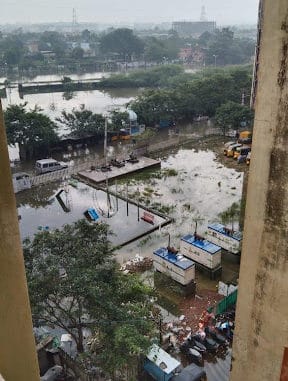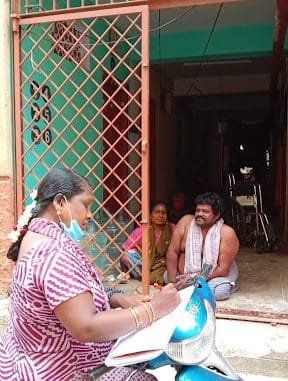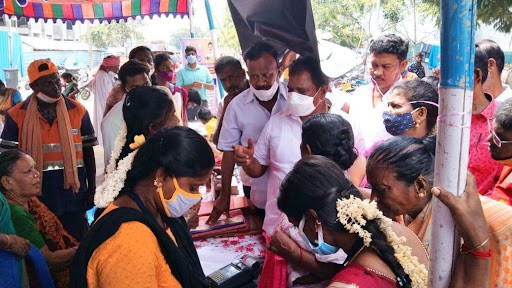Chennai’s recent history is marked by a string of disastrous weather events, particularly floods. The city’s water woes are not new, but the erratic nature and increased frequency of floods and droughts have raised questions regarding its in a climatically unstable world and what resilience might look like in the future.
A large number of initiatives under ‘Climate Adaptation’ and ‘Urban Resilience’ have been mooted, and designed by bureaucrats, technical experts and consultants. These responses range from watershed management to urban development schemes to ecological restoration of waterbodies.
But the story of top-down climate adaptation measures has less to do with the crisis at hand and more to do with a neoliberal imagination of what a city should look like.
Poorly defined measures of adaptation and resilience
This is quite obvious in Chennai’s case. Flood mitigation efforts, sanctioned under the guise of climate adaptation, become a proxy for eviction and displacement of the urban poor. Over the last two decades, more than 60,000 families, roughly 170,000 individuals, were forcibly evicted from core areas of the city and moved to resettlement colonies on the outskirts.
A large number of them were under the pretext of flood mitigation and restoration of water bodies. In several instances, large chunks of land have been handed over for real-estate development post evictions.
Despite evidence that floods in the city are caused by perpetual growth and an increase in built-up area, flood mitigation projects in the city continue to advocate for more infrastructural development as the way forward. Anything flies if it’s termed climate adaptation.
But the biggest failure of many top-down resilience-building measures, above and beyond the appalling environmental injustice is the limited scope of the term ‘resilience’ itself.
Projects like flood mitigation take a narrow view of environmental risks. Events like floods are treated as singular events that need to be mitigated, contained or managed through technical interventions.
However, the environmental crisis is multi-dimensional, resulting not just in the short-term destruction of property, but also affecting education, health, livelihood patterns, financial security, and social relations, in the medium as well as the long term.
A comprehensive strategy for resilience in a city like Chennai would involve the assessment of site-specific environmental risks and steps to tackle them using grounded and locally-relevant strategies.
Read more: Government should not use slum eviction to further ‘Singara Chennai’ agenda : Migration expert
Story of resilience in Perumbakkam
One such story is brewing in Perumbakkam, a neighbourhood on the outskirts of Chennai.
Perumbakkam is one of the largest resettlement sites in Chennai. It was built by the Tamil Nadu Urban Habitat Development Board (TNUHDB), formerly the Tamil Nadu Slum Clearance Board, to accommodate the people who were forcibly evicted from the city.
Perumbakkam has over 20,000 tenements and more are being built every day.
In many ways, Perumbakkam is a place where resilience comes to die. For starters, the entire site is located on a giant marshland which is extremely flood prone. And these are people who were moved away from riverbanks in order to protect them from floods!
The resettlement colony is characterized by the poor quality of housing, acute scarcity of basic resources like water and electricity, and lack of access to quality education. These woes have been made worse by the fact that the livelihood options in this area are highly limited, thereby keeping poverty rates perpetually high and opportunities for social mobility low.
The effect of environmental events like floods in Perumbakkam will be a combination of economic, health, social and cultural risks. For instance, one of the gravest concerns during the floods was the lack of access to healthcare. People had to wade through water, carrying their sick family members for 10+ kilometres to get medical assistance. Preparing for environmental risks, therefore, must also focus on lowering the vulnerability quotient of these communities on many different fronts.
Community fellows of Perumbakkam step up
That is precisely what a small cohort of Community Fellows belonging to the Information and Resource Centre for Deprived Urban Communities (IRCDUC) are doing in Perumbakkam.
Community Fellows are women from Perumbakkam who have been trained by IRCDUC to collect data, liaise with authorities and mobilise the community in order to secure housing rights and community development schemes for the residents.
Climate change adaptation doesn’t figure outwardly in their everyday work. But threads of resilience-building and adaptation are visible throughout. The work of the Fellows takes a number of different forms.
Some of them include:
- Liaising with the local government authorities to create better and faster feedback loops
- Creating systems to ensure women, particularly those from marginalized and disadvantaged groups, are able to access funds and government schemes
- Helping local residents mobilize and fight for better housing and improved access to services like education, health, food, technical training, etc
- Acting as disaster respondents, relief agents and community stewards during floods and other crises
- Incubating and leading initiatives like community gardens, education centres, etc.
Read more: Residents in resettlement colonies struggle with many aspects of daily life: IRCDUC study
Grounded resilience in Perumbakkam
How do these actions constitute grounded resilience? Regardless of the specific nature of the work, the purpose of the Field Coordinators is simple: to help community members bounce back from difficulties and improve their capacity to face risks, environmental or otherwise.
Resilience, in this context, is about helping people tide over big and small crises, environmental or otherwise, using a wide range of strategies.
For instance, helping people change their bank branch to a nearby one allows them to access their resettlement compensation quickly. This extra cash can prove crucial during the initial months of resettlement and cushion them from the impact of unexpected crises.
Monthly government pension drives, organized by Coordinators help widows, women without a means of subsistence and differently-abled individuals to access their primary and sometimes only source of income.
During events like floods, the extensive survey data collected by Coordinators allow them to target the most vulnerable groups for the distribution of relief materials.
The strategies adopted by Field Coordinators are those that accommodate the specific needs and requirements of their community and are an example of locally imagined and grounded resilience.
A work in progress
This is not to say that these strategies have been perfected or that they are always effective. Not all initiatives are enthusiastically received by the community and some tend to fail, often because they do not figure very high up in the community’s priority list.
For instance, medical camps and free health services see very low attendance.
Others run into administrative and technical roadblocks. The legal bottleneck surrounding permissions is a good example: the land on which the Perumbakkam tenements stand is not owned by the community and instead, lies with the State.
This ensures that most ideas never see the light of day. The process of identifying the most effective and engaging strategies is an ongoing one.
Another impediment is the lack of an active climate discourse in the area. As such, resilience emerges as a byproduct of their work in securing better housing rights for their community members. But going beyond this limited frame will allow broader and more comprehensive adaptation strategies to emerge.
In spite of these difficulties, the story of grounded resilience in Perumbakkam is an exciting and empowering contradiction to the techno-centric and top-down climate adaptation strategies that are currently in vogue.
The work of these women affirms the notion that civil society groups and non-governmental organizations need not represent or speak for them. Rather, empowered community members themselves are best placed to articulate and craft comprehensive and sensitive solutions to their problems.
Finally, it demonstrates the need for a multi-dimensional approach to resilience-building, moving beyond crisis management to capacity building, community empowerment and decentralized governance.
[This article was authored as part of the Grounded Imaginaries project, an Indo-Australian initiative to amplify stories of transformative responses to the climate crisis.]


